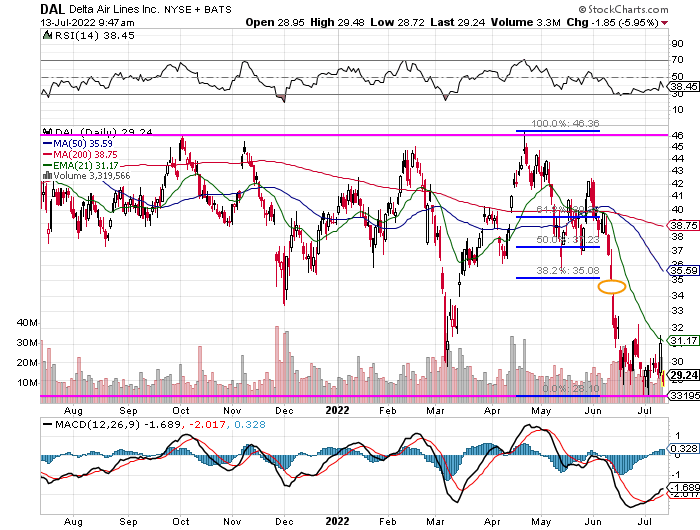On Wednesday morning, Delta Air Lines (DAL) released the firm’s second quarter financial results. The firm posted adjusted EPS of $1.44 (GAAP EPS: $1.15) on operating revenue of $13.8B (adjusted operating revenue of $12.3B). The adjusted bottom line number fell well short of the $1.66 that Wall Street had been looking for, but is up huge from the $-1.07 Q2 2021 print. The operating revenue print, however, was not only good enough for 93.5% year over year growth, but managed to beat consensus view.
Operating margin of 11% produced income of $1.5B. Operating cash flow of 2.5B produced free cash flow of $1.6B after investing $864M in the business. The firm paid $1B on debt and finance lease obligations over the three months ending June 30th.
Passenger traffic generated revenue of $10.958B, down 4% from Q2 2019, while cargo generated revenue of $272M, up 46% from Q2 2019. On the expense side, aircraft fuel and related taxes grew 41% from Q2 2019 to $3.223B, while salaries and related costs grew 4% from Q2 2019 to $2.955B. Delta also rewarded its staff with a 4% base pay increase for eligible scale and merit employees globally on 1 May.
By Region
Domestic sales drove revenue of $8.318B, up 3% from Q2 2019.
Domestic capacity remained down 11% from Q2 2019.
Atlantic sales drove revenue of $1.701B, down 9% from Q2 2019.
Atlanttic capacity remained down 17% from Q2 2019.
Latin American sales drove revenue of $745M, down 1% from Q2 2019.
Latin American capacity remained down 10% from Q2 2019.
Pacific sales drove revenue of $194M, down 70% from Q2 2019.
Pacific capacity remained down 74% from Q2 2019.
Key Statistics
Revenue passenger miles were down 18% from Q2 2019.
Available passenger miles were down 18% from Q2 2019.
Passenger revenue per available seat mile was up 18% from Q2 2019.
Total revenue per available seat mile was up 34% from Q2 2019.
Cost per available seat mile was up 44% from Q2 2019.
Average price per fuel gallon was $3.74 up 80% from Q2 2019.
For The Current Quarter
Delta expects capacity to land 15% to 17% from Q3 2019, but total revenue to increase 1% to 5% from that same quarter. Operating margin for Q3 2022 is expected to land in between 11% and 13%, while gross capital expenditures add up to a rough $1.8B. The firm sees adjusted net debt of about $20B.
Balance Sheet
As of June 30th, Delta had a net cash position of $10.77B, and current assets of $17.313B. This includes $1.734B in inventories (parts, fuel). Current liabilities amount to $26.324B. This places the firm’s current ratio at 0.66. Given what the airlines have been through, a lousy looking current ratio does not surprise. That said, it is what it is. It must also be pointed out that six months ago, Delta’s current ratio was 0.76, so the balance sheet has weakened.
Total assets add up to $74.805B including $15.75B worth of “goodwill” and other intangibles. This comes to 21.05% of total assets, which is a lot better than we have seen elsewhere. Total liabilities less equity comes to $70.994B. This includes $22.903B in debt and finance leases. That line is down from $25.138B six months back. It is clear that Delta is trying.
My Thoughts
Obviously there is enough not to like about the industry as well as Delta at the moment. The post-pandemic “revenge” vacation and business travel surge has been hijacked first by inflation. Many folks just can’t afford to travel in 2022 the way that they had hoped a year ago, and two… by the pandemic itself that is not quite through with us, as new sub-variants keep messing with personal and economic freedoms.
My opinion is that investing in airlines in 2022 is a lot like gambling. It may work out fine for the investor. That said, the investor can not be surprised if it does not.

DAL has traded in a range since last autumn. The shares have topped out in the $45/$46 area on four distinct occasions since early October, while bottoming in the $29/$30 area three times since March if one counts June and July as two. Relative Strength is weak, but not oversold. The daily MACD, while exhibiting a potential bullish crossover of the 26 day EMA by the 12 day EMA, can be somewhat discounted as both of those moving averages reside well below zero.
Shareholders desperately need the shares to hold $29. That spot cracks and the shares should give up multiple percentage points. Readers can see that DAL touched its 21 day EMA on Tuesday and that the shares were immediately slapped down.
Best case for the bulls would be after the stock settles an attempt is made to fill the gap from early June. Such a move would require a 38.2% fibonacci retracement of the April through July selloff, so it is technically feasible. Not feasible for me to buy equity though. Rather than spend capital on equity, a true believer could get long a November $29/$35 bull call spread for a net debit of roughly $2.10. Not a perfect solution, but better than laying out 29 clams.
Get an email alert each time I write an article for Real Money. Click the “+Follow” next to my byline to this article.
Source: https://realmoney.thestreet.com/investing/if-you-re-a-true-believer-in-delta-air-lines-here-s-how-to-trade-it-16051749?puc=yahoo&cm_ven=YAHOO&yptr=yahoo